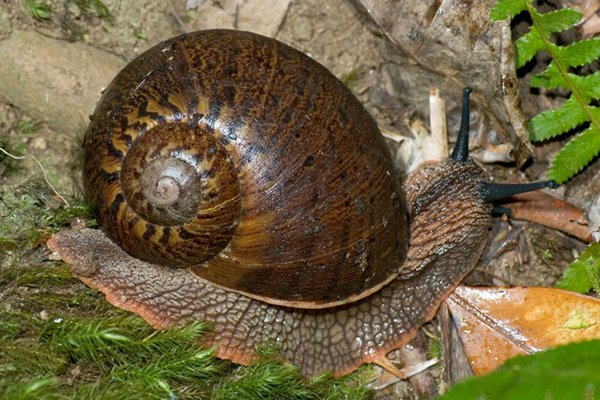Giant Panda Snail
Giant Rainforest Snail
Larger than a tennis ball, the Giant Panda Snail is Australia's largest land snail.
Identification
Shell is helicoid (spiral) in shape and has dark brown to fawn colouration with a series of black radial stripes begining in the centre and spiraling out. The soft fleshy foot is grey with a scale-like surface and a light orange fringe around the perimeter of the foot.
This species has two pairs of tentacles, the upper pair is twice as long as the lower pair and contains the snails eyes, both tenticals are black. A thick black stripe extends along the center of the the head from the eye stalks to the shell. Approximately half way down the body, covered by the shell, is the anus where long worm-like faeces are expelled, as well as the pnuemostome (breathing pore).

© CC BY-NC-SA 4.0
Habitat
This large snail can be found sub-tropical rainforest where it forages in the leaf litter of the forest floor. Like other snails it is more active during and after rain to prevent water loss from its soft body. This species will shelter under tree roots and logs but also within the leaf litter in forest clearings. The Giant Panda Snail has never been recorded climbing higher than 50cm above the ground.
Distribution
The Giant Panda Snail is distributed on the eastern side of the Great Dividing Range from just north of Brisbane in southern Queensland to Smiths Lake on the mid north coast of New South Wales.
Seasonality
Giant Panda Snails are active year round, however they are unlikely to be found since they are mostly nocturnal. In addition to this, like other land snails they only forage during or after rain.
Feeding and diet
In the wild this species feeds on the fruiting bodies of fungi on the forest floor, one study found indications that Giant Panda Snails feeding on the fruiting bodies of the fungus Polyporus varius (Order Aphyllophorales). Only part of the snail's foot is exposed and out of the shell while feeding, even the mouth remains hidden while the animal eats.
The captive diet for Giant Panda Snails kept at the Australian Museum includes mushrooms, some soft fruit and and an artificial mixture called 'Mollusc Mix' which was originally produced by the Zoological Society of London to raise the endangered Partula Snails of French Polynesia. Mollusc mix is specially formulated to provide protein, vitamins, calcium and other nutrients to snails and slugs which usually feed on fungi and algae in the wild. Additionally, Cuttlebone (the hard internal skeleton of another kind Mollusc; Cuttlefish) is provided as a source of calcium which snails need for healthy shell growth.

© CC BY-NC-SA 4.0
Life history cycle
Giant Panda Snails begin life as an egg, hatching snails are tiny, hatching from their translucent eggs at about 15mm in length. Young snails grow relatively slowly and may not even double this size within the animal's first year. Like all gastropods the shell of the snail grows in a spiral fashion adding a new ring of calcium carbonate around the opening at each growth stage.
Breeding behaviours
Giant Panda Snails are hermaphroditic, meaning that individuals possess both sperm and eggs. Mating occurs over night whereby the two snails exchange sperm to fertilise each others eggs. Fifteen to 20 cream coloured eggs are laid over a period of a few days in a shallow burrow (about 50mm deep) and are left covered with leaf litter. These nest sites have been recorded in open areas, not under logs or amongst tree roots. These eggs are relatively large in size for snails, at around 18mm long and 2g in weight, they are truly giant.
Breeding in the wild has been recorded in the warm and humid conditions during February, however the species can breed year round in captivity if the right conditions are supplied.
Predators
These relatively large meals are favoured by birds such as the Albert's Lyrebird, Menura alberti, Superb Lyrebird, Menura novaehollandiae, and the Noisy Pitta, Pitta versicolour, which will smash snails open by slamming them down onto a rock acting like an anvil.
Land snails are host to parasites such as Nematodes (roundworms) which occur within the snail’s digestive system and can be passed on to other hosts.
Support the Australian Museum
Your donation supports the exceptional work of our inspiring scientists, explorers and educators as they help to protect Australia’s vital natural and cultural heritage for generations to come.
Donate nowReferences
- Henderson, A, Henderson, D. and Sinclair J. 2008. Bugs Alive! A Guide to Keeping Australian Invertebrates. Museum Victoria. Melbourne.
- Murphy, M. 2002. Observations on the behaviour of the Australian land snail Hedleyella falconeri (Gray 1834) (Pulmonata: Caryodidae) using the spool-and-line tracking technique. Molluscan Research. Vol 22: 149-164.
- Pizzey, G. and Knight, F. 1997. Field Guide to the Birds of Australia. Harper Collins. Pymble.
- Stanistic, J. Burwell, C. Raven, R. Monteith, G. and Baehr, B. 2005. Terrestrial Invertebrate Status Review. Queensland Centre for Biodiversity. Queensland Museum. Brisbane.
Further reading
- NSW National Parks and Wildlife Service. 2003. Mitch the Rainforest Snail: Teacher resource book. Threatened Species Unit.


